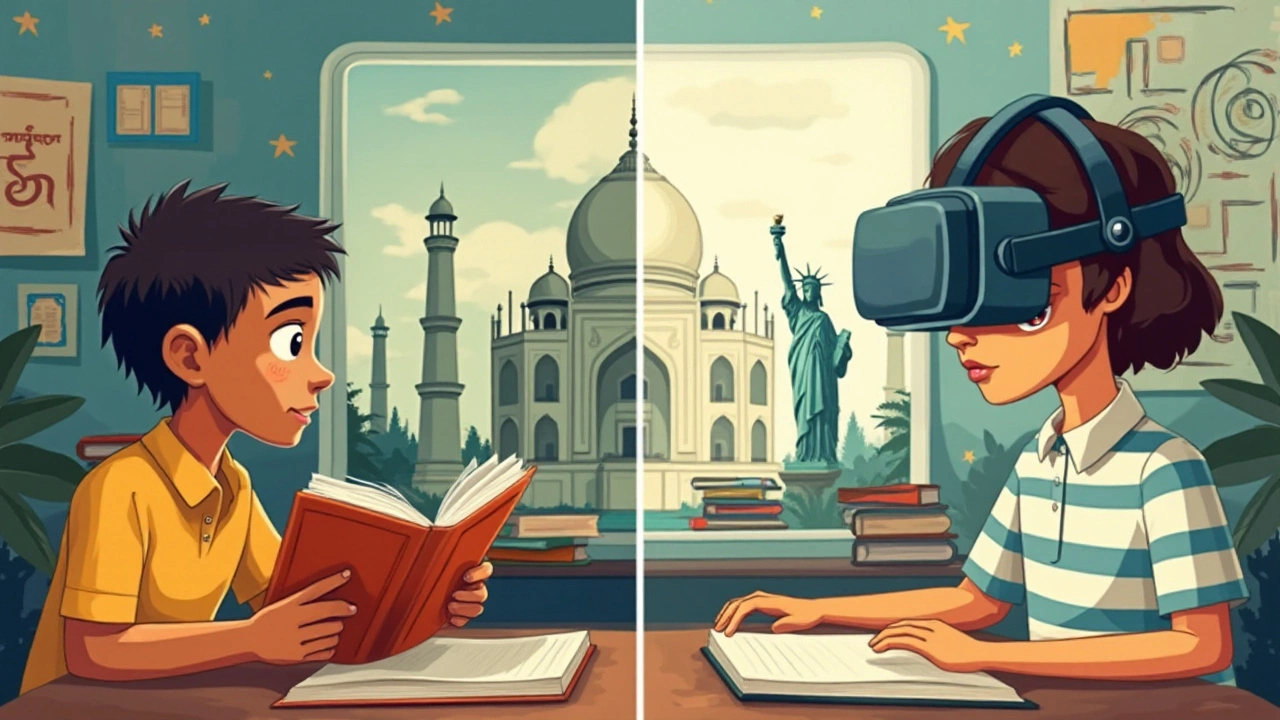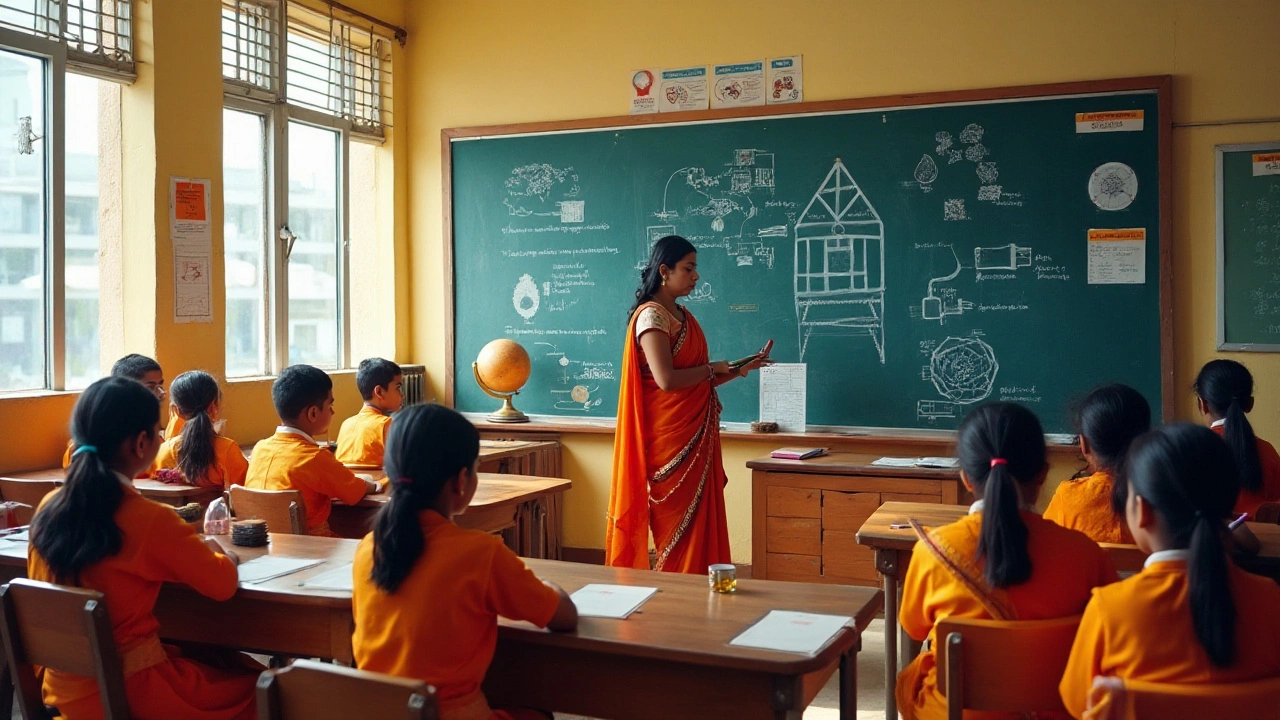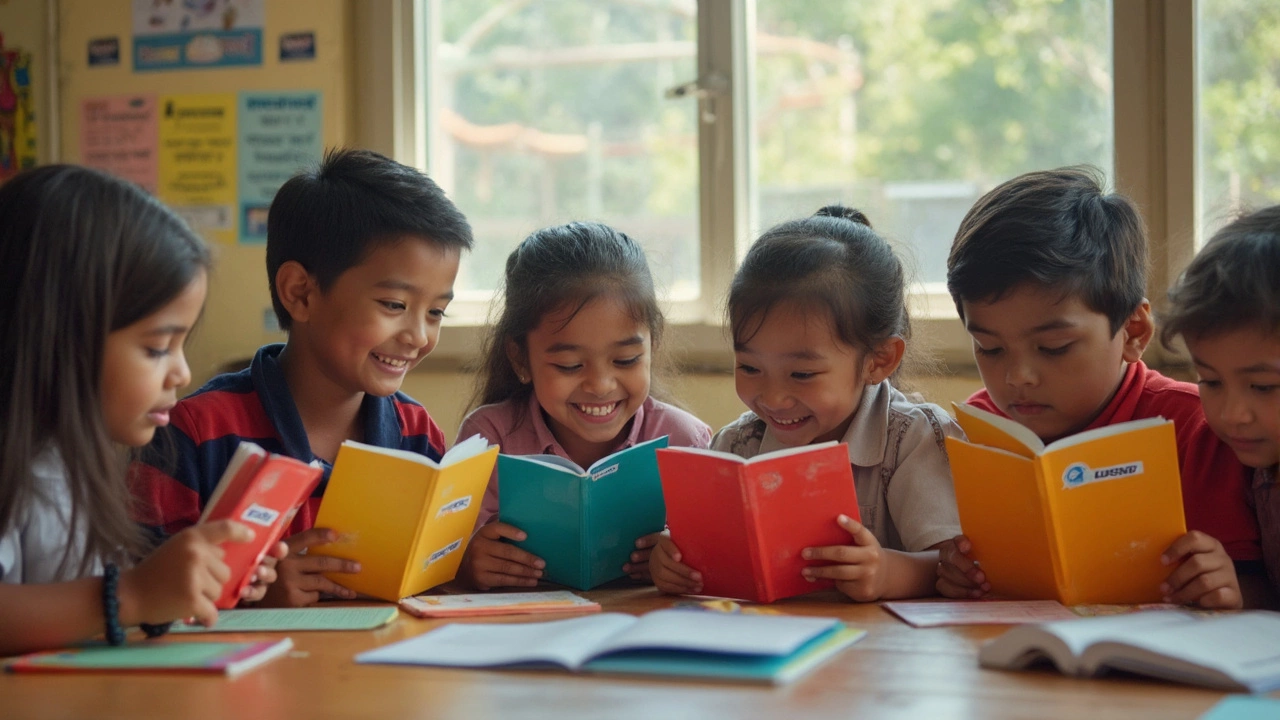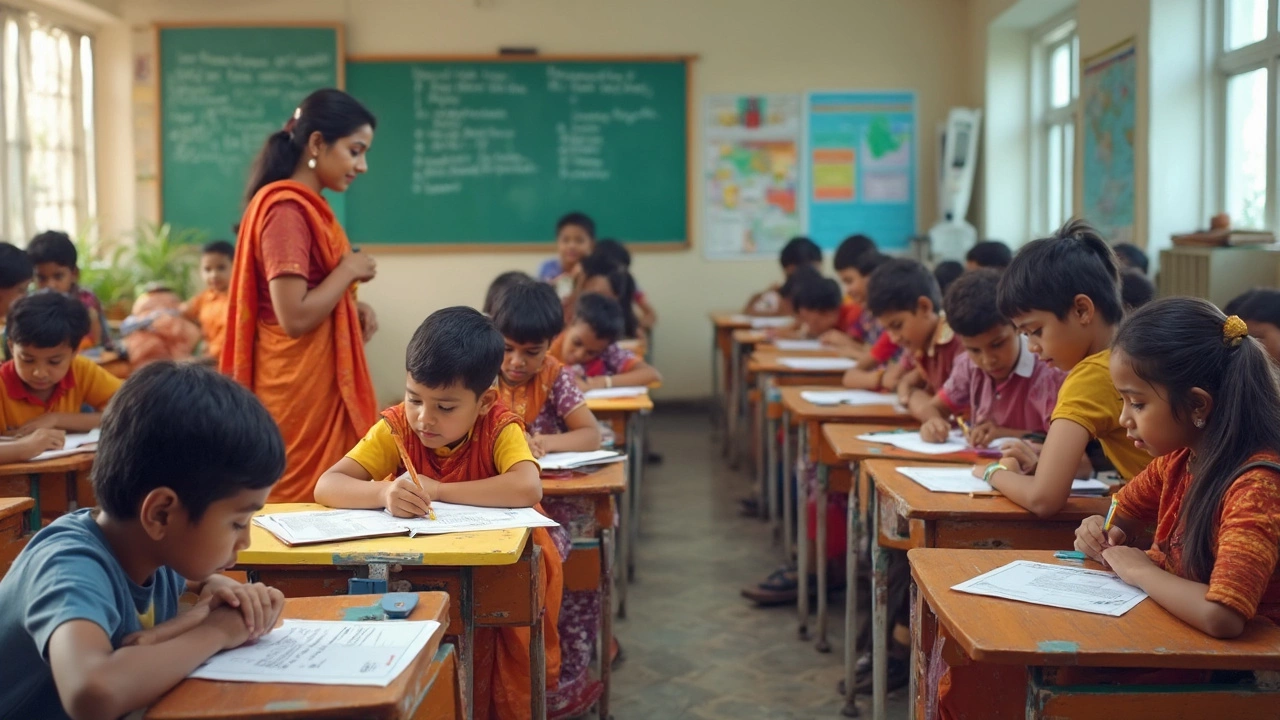The debate over whether the US or Indian education system holds an edge often comes down to what one values—innovation and flexibility or rigor and discipline. Education isn't just about memorizing facts; it's about shaping minds for the future. In the US, the approach is generally more flexible, encouraging critical thinking and creativity, while India's system, particularly under the CBSE syllabus, is renowned for its structured and rigorous methodology.
In the following sections, we explore the key differences that define these educational landscapes. From curriculum design to assessments, each system has something unique to offer. Whether you're a parent deciding on your child's education or a student pondering where to pursue higher studies, understanding these differences is crucial.
- Educational Frameworks and Philosophies
- Curriculum Design and Flexibility
- Examination and Assessment Methods
- Role of Technology and Innovation
- Student Well-being and Extracurriculars
- Global Recognition and Higher Education Prospects
Educational Frameworks and Philosophies
When diving into the education system of the United States and India, it's imperative to not only look at the structures but also the philosophies that shape these frameworks. The United States boasts a system that champions individualism and creative thinking. Schools often encourage students to discover their passions early on, offering a variety of courses and activities that cater to diverse interests. The educational philosophy here leans heavily on constructivist theories, where learning is viewed as a dynamic process of constructing knowledge, based on personal experiences and hypotheses of the environment. This encourages a pedagogy that's more about guiding and less about dictating, fostering an environment where questioning is as important as answering.
In contrast, India’s education system, particularly in the context of the CBSE syllabus, can be seen as more didactic and standardized. The CBSE, known for its rigorous academic focus, is committed to providing a strong foundational knowledge with well-structured courses that emphasize discipline and systematic study. Education here is often seen as a means to secure societal and familial status, and thus, pressure to excel academically can be immense. This kind of framework instills a sense of diligence and perseverance in students, ensuring they have a solid grasp on theoretical concepts. "Education is the most powerful weapon you can use to change the world," Nelson Mandela once said, highlighting the transformative power of structured learning even within a challenging framework.
The differences extend into how innovation and adaptability are perceived. In the US, the role of technology and inventive practices is pivotal, with schools readily integrating the latest digital tools to enhance learning experiences. This is part of a broader philosophy that values adaptability in a fast-paced world. On the other hand, Indian education might not have the same level of technological integration due to varying resource availability across regions, yet it stands strong with its deep-rooted focus on mathematics and sciences, contributing significantly to global tech industries.
Yet, both systems are navigating substantial changes. With globalization, there's been a noticeable shift, particularly in India, towards embracing western educational methods. International schools have increasingly adopted blended curricula that attempt to merge the best of both systems. Principally, this involves combining the critical and analytical prowess emphasized in American schools with the rigorous, foundational approaches of Indian education.
This evolving landscape in educational frameworks across the US and India brings about a valuable dialogue—how can we balance strict academic standards with the nurturing of innovation? One could argue that each system has valuable lessons for the other, and as these systems evolve, they create more room for students to thrive in a globally competitive environment. As educators and policymakers continue to learn from these models, they have the opportunity to craft educational experiences that prepare students not just for exams, but for life.
Curriculum Design and Flexibility
When we dive into the heart of educational systems, the curriculum design and its flexibility take center stage. In the United States, the approach to curriculum is widely decentralized, giving local education agencies considerable latitude to tailor what students learn based on regional and community needs. The flexibility inherent in the U.S. educational approach encourages schools to incorporate diverse subjects and interdisciplinary studies. This kind of adaptability within the curriculum means that students often have the chance to explore electives that range from arts to cutting-edge technology.
Unlike the broad liberties seen across the Atlantic, India's education system, particularly under the Central Board of Secondary Education (CBSE), is characterized by uniformity and standardization across schools. The CBSE syllabus is known for its comprehensive and structured approach, ensuring that regardless of geographic differences, students receive the same educational foundation. This focus builds a solid base for subjects like mathematics and science. However, critics argue that this standardization can sometimes stifle creativity and limit students' opportunities to pursue diverse interests during their formative years.
"Education in India, through its rigorous structure, instills discipline in students that is often unmatched," notes renowned educational consultant Dr. Anil Kumar.In the context of flexibility, the CBSE has been introducing gradual reforms to incorporate value-based education and skill development. These initiatives are essential in maintaining relevance in a global landscape where skills over rote learning are becoming increasingly essential. Nevertheless, the rigidity of traditional exam-centric models often prevails, which can lead to high levels of student stress.
The differences in curriculum between the two nations are also reflected in higher education prospects. In the U.S., having the freedom to select varied subjects and form unique career paths can enhance students' college applications. In contrast, CBSE graduates are often lauded for their strong grounding in analytical and quantitative skills, which opens doors, particularly within the STEM fields, worldwide. This division in curriculum design and flexibility certainly influences student adaptability and innovation.
| Aspect | USA | India (CBSE) |
|---|---|---|
| Curriculum Flexibility | High | Moderate |
| Standardization | Low | High |
| Focus Areas | Interdisciplinary Studies | Core Subjects (Math, Science) |
In essence, when considering curriculum design and flexibility as a comparative parameter, these educational systems present distinct philosophies. The American model emboldens choice and customization, fostering well-rounded individuals ready for various challenges. At the same time, India's CBSE system ensures consistency and depth in foundational knowledge, albeit sometimes at the expense of creative freedom.

Examination and Assessment Methods
In any educational system, the way examinations and assessments are conducted plays a pivotal role in shaping the academic journey of students. The distinction between the examination strategies of the education system in the USA and India, particularly the CBSE syllabus, highlights contrasting philosophies and practices. In the United States, assessments are typically more versatile, aiming to evaluate a range of skills, including analytical abilities, creativity, and practical application of knowledge. This flexibility is reflected in performance-based assessments, which include portfolios, project work, and presentations. Students often engage in assessments throughout the course, which lightens the pressure of end-term examinations, allowing for a more comprehensive understanding of the subject matter.
Conversely, India's approach, particularly within the CBSE framework, emphasizes standardized testing. The focus largely remains on rigorous end-of-year examinations, with a structured paper format intended to test the depth of a student’s knowledge in systematic, segmented subjects. While critics argue that this can promote rote learning, defenders of the system point to the undeniable improvement in understanding and discipline that such structured assessments can bring. The meticulous nature of the exams ensures that students develop a command over theoretical concepts, making them adept at mastering detailed coursework—which is a hallmark of the Indian genotype towards education.
Standardized testing in India has been a subject of much debate. According to educational experts, “A balanced approach in assessment methodologies combining traditional and modern techniques can lead to a holistic development of student capabilities.”
“Examinations are not just a test of knowledge, but a tool that determines a student's future learning trajectory,” says Professor Arvind Krishna, an educator known for his research in pedagogic efficacies.This perspective is shared by many who aim to find a middle ground that could potentially combine the best of both worlds.
However, whether the goal is to enter competitive fields or to seek opportunities abroad, results on standardized tests are the deciding factor for many Indian students. Meanwhile, American students may favor assessments that factor in coursework, participation, community service, and extracurricular involvement to offer a more rounded measure of a student’s capabilities. When contemplating higher education, the global recognition of both methods is influenced by these fundamental differences in how academic prowess and potential are measured. Each system, in its unique way, provides valuable insights and contributes globally to the nurturing of young minds.
Role of Technology and Innovation
In today's fast-evolving world, technology and innovation have become cornerstones of education, transforming how knowledge is delivered and received in both the USA and India. The American education system has long embraced technology, integrating it seamlessly into classrooms from early learning stages through to higher education. Classrooms in the US often boast smart boards, digital textbooks, and tablets, which foster an interactive and engaging learning environment for students. Teachers leverage online platforms and educational software to offer personalized learning experiences, catering to diverse student needs.
India's educational landscape, traditionally known for its print-heavy resources, has witnessed a remarkable shift in the last decade as well. The Central Board of Secondary Education (CBSE) has been proactive in integrating digital tools within its curriculum. Initiatives like the National Digital Library and eLearning programs aim to bridge the technological gap among schools across the nation. Despite challenges pertaining to unequal digital access, especially in rural regions, there is ongoing progress to ensure equitable opportunities for all students through government initiatives and public-private partnerships. These changes have underscored the importance of technology as a potent equalizer in education.
Statistics indicate that in schools where technology is effectively implemented, students have shown improved retention rates and a deeper understanding of complex subjects. According to a study by the Department of Education Technology from EdTech Magazine, "students in classrooms with digital tools outperform their peers by 18 percent in core subject assessments." This underlines the crucial role that tech-based learning plays in shaping well-rounded, knowledgeable students ready to tackle global challenges.
Bill Gates once remarked, "Technology is just a tool. In terms of getting the kids working together and motivating them, the teacher is the most important." This statement highlights the symbiotic relationship between technology and educators; technology empowers teachers to become facilitators of learning rather than mere transmitters of information.
While the USA continues to lead in technological integration, India is catching up quickly with initiatives like digital classrooms and online platforms tailored to the CBSE syllabus. Both countries invest significantly in STEM (Science, Technology, Engineering, and Mathematics) education, nurturing skills vital for the 21st-century workforce. For education stakeholders, understanding these dynamics can inform strategies for technology adoption and curriculum development, ultimately culminating in enriched educational outcomes for students across the globe.

Student Well-being and Extracurriculars
When considering the landscape of education in both the United States and India, student well-being and the role of extracurricular activities are vital aspects that reveal much about the priorities and environment of each system. In the US educational framework, there is a pronounced emphasis on the holistic development of students. Schools and colleges across the country widely encourage participation in a broad range of extracurricular activities, including sports, arts, clubs, and community service projects. This approach is driven by the belief that such activities are not mere add-ons but integral parts of the educational experience that help students develop important social skills, leadership qualities, and personal interests.
In comparison, the Indian education system, particularly under the CBSE board, has traditionally focused more heavily on academic achievements, often leading to high levels of pressure and competition among students. However, a shift is gradually occurring, recognizing the importance of extracurriculars in shaping well-rounded individuals. Schools are beginning to incorporate more structured extracurricular programs, sometimes integrating them into the curriculum to reduce the overwhelming homework and study loads. Despite these efforts, there remains a strong cultural emphasis on academic performance, with extracurriculars often viewed as secondary priorities.
Nobel laureate Amartya Sen once remarked, "Education is not just about learning how to read and write. It’s about acquiring skills that will help you navigate life." This underscores the growing recognition of education systems globally to include more balanced approaches.
Statistics indicate a positive correlation between student engagement in extracurricular activities and mental health. A report by the National Center for Education Statistics from 2022 showed that students participating in such activities had 20% higher life satisfaction and academic performance scores. In India, similar trends have been noted, though the scope and support for extracurricular involvement vary significantly based on the institution and region.
Interestingly, both educational systems have been making concerted efforts to enhance student well-being through policies that address stress, mental health, and the value of diverse interests. Incorporating technology also plays a significant role; apps and online programs are emerging in both countries, designed to balance academics with relaxation and enjoyment, aiding students in global perspectives and skills outside traditional subjects. It is clear that no matter the differences in structure, both nations are moving towards valuing and nurturing the complete well-being of students through a blend of education and extracurricular engagement.
Global Recognition and Higher Education Prospects
When it comes to higher education and global recognition, both the US and Indian education systems have their distinct advantages and challenges. The US education system is widely revered for its broad acceptance and high regard on the international stage. This is largely due to the innovation, diversity, and flexibility within its higher educational institutions, which attract students from all over the world. Numerous American universities consistently rank at the top in global standings, making them a popular choice for students seeking a world-class education. In fact, institutions like MIT, Harvard, and Stanford are household names, synonymous with academic excellence.
In contrast, while the Indian education system may not have the same global cachet as its American counterpart, it is slowly gaining traction. The Central Board of Secondary Education (CBSE) is recognized for its rigorous academic standards and is often appreciated for its focus on science and mathematics. Indian students consistently perform well in international talent pools, landing in top universities worldwide. This success highlights the effectiveness of India’s rigorous schooling in preparing students capable of excelling in demanding global environments.
However, the path to international recognition involves overcoming significant challenges. Indian students often face the 'recognition gap' where CBSE credentials aren't as readily understood or valued in certain Western nations when compared to degrees from American institutions. To bridge this gap, increasing numbers of Indian institutions are partnering with foreign universities, enhancing their syllabuses to meet international standards and improve mutual recognition of qualifications. A significant step has been taken with India's commitment to the National Education Policy 2020, aiming for inclusion, equity, and global exposure.
"As the world becomes more interconnected, understanding across different educational systems can unlock numerous opportunities," says Dr. Mohan Agrawal, an eminent educator.
The future holds many possibilities for higher education in both countries. As economies globalize, there is an increasing demand for students who are not only academically proficient but also culturally competent and broadly knowledgeable. U.S. institutions are often funded generously, benefiting from research grants and infrastructure resources that support cutting-edge research and innovation, thereby enhancing students' learning experiences and prospects in diverse fields.
On the other hand, India is focusing increasingly on strengthening its educational infrastructure, fostering research initiatives, and nurturing partnerships with foreign universities. Prestigious Indian Institutes of Technology (IITs) and Indian Institutes of Management (IIMs) are making their mark globally, producing a steady stream of brilliant minds in the fields of engineering, technology, and management. This blend of tradition with modernity positions India competitively on the global education map, promising rich and varied opportunities for its graduates. For aspiring students, it becomes imperative to weigh options based on personal goals, the autonomy of learning environments, and the reach of their ambitions in choosing between these diverse global education prospects.



